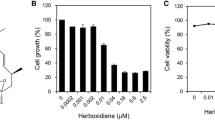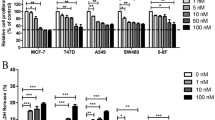Abstract
Purpose
In this study, we examined the antiangiogenic effect of oroxylin A in vitro and in vivo and explored the potential mechanisms for this effect.
Methods
Transwell assay and tube formation assay were used to evaluate the effects of oroxylin A on vascular endothelial growth factor (VEGF)-induced migration and tube formation of human umbilical vein endothelial cells (HUVECs). Rat aortic ring assay was also employed to assess the effect of oroxylin A on microvessel outgrowth from rat aorta. Human tumor xenografts model in nude mice was further used to investigate the antiangiogenic activity of oroxylin A in vivo. Western blot analysis was used to investigate the related mechanism.
Results
Oroxylin A remarkably suppressed the VEGF-stimulated migration and tube formation of HUVECs. It also inhibited microvessel sprouting from rat aortic ring in vitro. In addition, it suppressed the angiogenesis of xenograft tumor in nude mice, which concurred with the inhibition of tumor growth. Moreover, oroxylin A blocked VEGF-induced phosphorylation of KDR/Flk-1 and related downstream signaling molecules, including p38 mitogen-activated protein kinase, extracellular signal-regulated kinase and Akt.
Conclusion
Oroxylin A possessed antiangiogenic activities in vitro and in vivo, which could be an underlying mechanism of its anticancer effect.






Similar content being viewed by others
References
Berger AC, Wang XQ, Zalatoris A et al (2004) A murine model of ex vivo angiogenesis using aortic disks grown in fibrin clot. Microvasc Res 68:179–187
Blagosklonny MV (2004) Antiangiogenic therapy and tumor progression. Cancer Cell 5:13–17
Cabebe E, Wakelee H (2007) Role of anti-angiogenesis agents in treating NSCLC: focus on bevacizumab and VEGFR tyrosine kinase inhibitors. Curr Treat Options Oncol 8:15–27
Carmeliet P (2003) Angiogenesis in health and disease. Nat Med 9:653–660
Carnesecchi S, Bras-Goncalves R, Bradaia A et al (2004) Geraniol, a component of plant essential oils, modulates DNA synthesis and potentiates 5-fluorouracil efficacy on human colon tumor xenografts. Cancer Lett 215:53–59
Colavitti R, Pani G, Bedogni B et al (2002) Reactive oxygen species as downstream mediators of angiogenic signaling by vascular endothelial growth factor receptor-2/KDR. J Biol Chem 277:3101–3108
Collins TS, Hurwitz HI (2005) Targeting vascular endothelial growth factor and angiogenesis for the treatment of colorectal cancer. Semin Oncol 32:61–68
Ellis LM, Takahashi Y, Liu W, Shaheen RM (2000) Vascular endothelial growth factor in human colon cancer: biology and therapeutic implications. Oncologist 5(suppl 1):11–15
Folkman J (2002) Role of angiogenesis in tumor growth and metastasis. Semin Oncol 29:15–18
Folkman J (2006) Angiogenesis. Annu Rev Med 57:1–18
Folkman J (2007) Angiogenesis: an organizing principle for drug discovery? Nat Rev Drug Discov 6:273–286
Goodwin AM (2007) In vitro assays of angiogenesis for assessment of angiogenic and anti-angiogenic agents. Microvasc Res 74:172–183
Hu Y, Yang Y, You QD et al (2006) Oroxylin A induced apoptosis of human hepatocellular carcinoma cell line HepG2 was involved in its antitumor activity. Biochem Biophys Res Commun 351:521–527
Huang C, Jacobson K, Schaller MD (2004) MAP kinases and cell migration. J Cell Sci 117:4619–4628
Jaffe EA, Nachman RL, Becker CG et al (1973) Culture of human endothelial cells derived from umbilical veins. Identification by morphologic and immunologic criteria. J Clin Invest 52:2745–2756
Jiang BH, Liu LZ (2008) AKT signaling in regulating angiogenesis. Current Cancer Drug Targets 8:19–26
Kakeji Y, Koga T, Sumiyoshi Y (2002) Clinical significance of vascular endothelial growth factor expression in gastric cancer. J Exp Clin Cancer Res 21:125–129
Kanno S, Oda N, Abe M et al (2000) Roles of two VEGF receptors, Flt-1 and KDR, in the signal transduction of VEGF effects in human vascular endothelial cells. Oncogene 19:2138–2146
Kitamura T, Asai N, Enomoto A et al (2008) Regulation of VEGF-mediated angiogenesis by the Akt/PKB substrate Girdin. Nat Cell Biol 10:329–337
Li HB, Chen F (2005) Isolation and purification of baicalein, wogonin and oroxylin A from the medicinal plant Scutellaria baicalensis by high-speed counter-current chromatography. J Chromatogr A 1074:107–110
Li HN, Nie FF, Liu W et al (2009) Apoptosis induction of oroxylin A in human cervical cancer HeLa cell line in vitro and in vivo. Toxicology 257:80–85
Ling Y, Yang Y, Lu N et al (2007) Endostar, a novel recombinant human endostatin, exerts antiangiogenic effect via blocking VEGF-induced tyrosine phosphorylation of KDR/Flk-1 of endothelial cells. Biochem Biophys Res Commun 361:79–84
Meyer RD, Rahimi (2003) Comparative structure-function analysis of VEGFR-1 and VEGFR-2: What have we learned from chimeric systems? Ann N Y Acad Sci 995:200–207
Min JK, Han KY, Kim EC et al (2004) Capsaicin inhibits in vitro and in vivo angiogenesis. Cancer Res 64:644–651
Nicosia RF, Bonanno E, Villaschi S (1992) Large-vessel endothelium switches to a microvascular phenotype during angiogenesis in collagen gel culture of rat aorta. Atherosclerosis 95:191–199
Restucci B, De Vico G, Maiolino P (2000) Evaluation of angiogenesis in canine mammary tumors by quantitative platelet endothelial cell adhesion molecule immunohistochemistry. Vet Pathol 37:297–301
Sathornsumetee S, Rich JN (2007) Antiangiogenic therapy in malignant glioma: promise and challenge. Curr Pharm Des 13:3545–3558
Shibuya M (2006a) Differential roles of vascular endothelial growth factor receptor-1 and receptor-2 in angiogenesis. J Biochem Mol Biol 39:469–478
Shibuya M (2006b) Vascular endothelial growth factor (VEGF)-receptor2: its biological functions, major signaling pathway, and specific ligand VEGF-E. Endothelium 13:63–69
Sonoda M, Nishiyama T, Matsukawa Y et al (2004) Cytotoxic activities of flavonoids from two Scutellaria plants in Chinese medicine. J Ethnopharmacol 91:65–68
Sun Y, Lu N, Ling Y et al (2009) Oroxylin A suppresses invasion through down-regulating the expression of matrix metalloproteinase-2/9 in MDA-MB-435 human breast cancer cells. Eur J Pharmacol 603:22–28
Tian X, Song S, Wu J (2001) Vascular endothelial growth factor: acting as an autocrine growth factor for human gastric adenocarcinoma cell MGC803. Biochem Biophys Res Commun 286:505–512
Vermeulen PB, Gasparini G, Fox SB et al (1996) Quantification of angiogenesis in solid human tumours: an international consensus on the methodology and criteria of evaluation. Eur J Cancer 32A:2474–2484
Weidner N (1995) Current pathologic methods for measuring intratumoral microvessel density within breast carcinoma and other solid tumors. Breast Cancer Res Treat 36:169–180
Wu ZQ, Guo QL, You QD et al (2004) Gambogic acid inhibits proliferation of human lung carcinoma SPC-A1 cells in vivo and in vitro and represses telomerase activity and telomerase reverse transcriptase mRNA expression in the cells. Biol Pharm Bull 27:1769–1774
Yang Y, Hu Y, Gu HY et al (2008) Oroxylin A induces G2/M phase cell-cycle arrest via inhibiting Cdk7-mediated expression of Cdc2/p34 in human gastric carcinoma BGC-823 cells. J Pharm Pharmacol 60:1459–1463
Acknowledgments
This work was supported by the National Natural Science Foundation of China (Nos. 30701032, 30472044, 90713038 and 30973556), International Corporation Program of China (2008DFA32120), and Natural Science Foundation of Jiangsu province (No. BK2009297).
Conflict of interest statement
We declare that there are no conflicts of interest.
Author information
Authors and Affiliations
Corresponding author
Additional information
Y. Gao and N. Lu contributed equally to this work.
Rights and permissions
About this article
Cite this article
Gao, Y., Lu, N., Ling, Y. et al. Oroxylin A inhibits angiogenesis through blocking vascular endothelial growth factor-induced KDR/Flk-1 phosphorylation. J Cancer Res Clin Oncol 136, 667–675 (2010). https://doi.org/10.1007/s00432-009-0705-2
Received:
Accepted:
Published:
Issue Date:
DOI: https://doi.org/10.1007/s00432-009-0705-2




